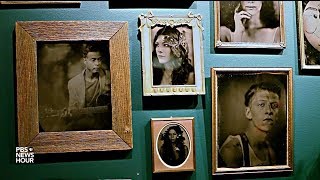AMNA NAWAZ: Photography has made mind-boggling advances over the last century-and-a-half. So many of us now have a camera in our smartphones. But in a story that comes to us by PBS station Milwaukee PBS, one woman in Wisconsin has rediscovered the art of taking photographs and developing film using techniques from the mid-1800s.
MARGARET MUZA, Photographer: I use a lot of old cameras, old lenses. The one I use the most is an 8x10 camera from 1903 with an old portrait lens. These machines are really simple. Really, it's kind of just a box with a lens on it, so it's not a complicated machine at all. That's what's amazing about them. Even though they're so old, you know, I'm using them over 100 years later. And I love that about them, because most of our modern technology doesn't work after two or three years. The first time I saw a tintype appearing in the fixer, I felt like I had seen a ghost. I got goose bumps, and I was just -- my eyes watered because it was so spooky and so beautiful. And I thought, how did that happen? How can this image be before my eyes? Which is something we don't think about when we're looking at images on a screen. So there's complete magic there, and I still feel that way every time I take a picture. I'm always surprised by what I see. It always turns out differently than imagined. The wet-plate process is an old photographic method that uses wet chemistry to make an image, instead of, say, film or negatives. I use aluminum plates and glass plates. So, then I use a collodion, which is a liquid emulsion that I pour onto that plate which becomes light-sensitive through a series of chemical steps. It sits in a bath of silver nitrate, where it becomes light-sensitive in the darkroom. And then I use developer that I make myself, and an old varnish recipe that's a Civil War era recipe. This process really attracted me because it's a little bit unpolished. So, the image is kind of messy. There's lots of artifacts that show up, little schmears, fingerprints. And I like the look of that. I really like photographing people. Someone by themselves is really, like, my ideal subject. I really like to be able to focus on every aspect of someone's face, lighting them perfectly, and then developing them perfectly. This process is fulfilling because it still really challenges me, I think, because I have so much to learn yet, I'm still really hooked, and it hasn't let me go, you know, because I really am challenged by it constantly. And I want to master it.












